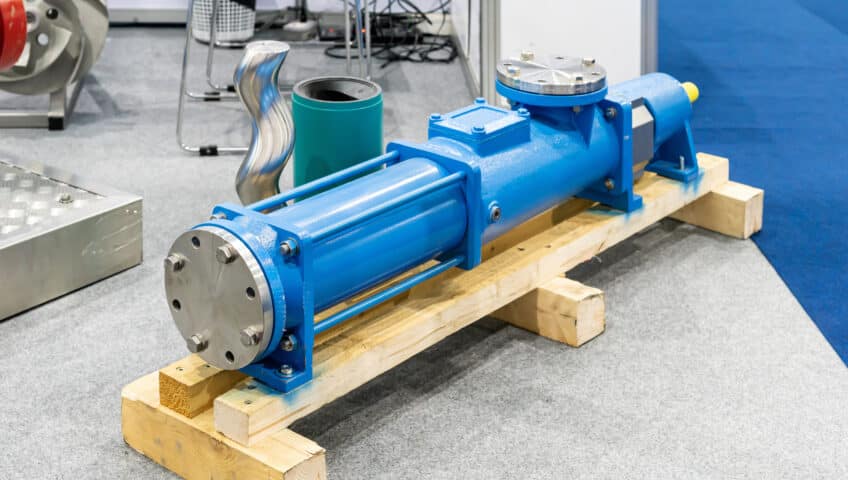
Types of Positive Displacement Pumps
Industrial pumps are separated into a few major categories—centrifugal pumps and positive displacement pumps. Each is built and behaves differently and has its own advantages. In many situations, positive displacement pumps are the best choice, but there are several options within this category. Here’s what you need to know about this type of pump, its advantages, and the different positive displacement pumps you can choose.
What Is a Positive Displacement Pump?
A positive displacement pump is designed to ensure that any pumping mechanism moves forward or is positive. This type of pump has an internal design that prevents and ensures no fluid will circulate back toward the pump’s inlet.
Positive displacement pumps work by drawing fluid into a cavity or chamber via a vacuum. As soon as the chamber is filled, the fluid in the pump will increase internal pressure. This causes the fluid to get discharged out the other end of the pump.
Advantages of Positive Displacement Pumps
Positive displacement pumps have a simple and unique design that makes them useful for various applications. Here are some of the advantages of this type of industrial pump.
Accurate & Predictable Flow
The chambers in these pumps are designed to hold a fixed volume, so the flow depends on the pump speed. Because of this, highly accurate calculations can be made about pump flow and output per revolution.
Consistent Pressure
This equipment will generally deliver constant pressure at levels higher than those required. This can be useful in applications with varying discharge pressures, such as spray operations, dosing applications, or tanker loading.
Various Viscosity Levels
Viscosity doesn’t affect these designs, meaning the equipment should be versatile enough to use with various viscosity levels. These pumps operate well with thicker fluids, which helps create higher pressures and flows.
Low Wear & Tear
Positive displacement pumps allow more speed regulation compared to centrifugal pumps. Lower speeds enable better handling of more solid or abrasive-laden materials, which lessens wear and tear on the pump.
Non-Slip Designs
All positive displacement pumps have minimum and maximum viscosity levels, the limits they are designed to handle. Slip will occur if fluids are reduced to a level below the pump’s designed limits. When this happens, the pump is less efficient, and seals can fail. But you can get positive displacement pumps in non-slip designs to prevent this.
Liquid Characteristic Preservation
When you’re working with liquids like gels, polymers, creams, or milk, preserving the characteristics of those liquids is essential. Some positive displacement pumps can regulate pump speed to ensure the precise requirements of the application are met.
Types of Positive Displacement Pumps
Fortunately, there are many different types of positive displacement pumps, and you can find one that meets your particular needs. Positive displacement pumps fall into two main categories, with several types of pumps within each.
Positive Displacement Reciprocating Pumps
This type of positive displacement pump operates by using a reciprocating motion to displace the fluid passing through the device.
Diaphragm Pump
Diaphragm pumps work by displacing fluid using a flexible elastomer cover. Fluid gets drawn into and expelled from the pump as the diaphragm expands and contracts. No seals are necessary because the dry and wet sections of the pump remain separate.
Piston Pump
Piston pumps have a reciprocating piston within a cylinder and check valves on both ends of the pump. The cylinder’s chamber expands, which drops the pump’s pressure and allows fluid to pass through the intake.
Plunger Pump
Plunger pumps work similarly to piston pumps but use a different mechanism. These pumps are commonly used where controlled, high-pressure flow generation is required, such as in oil and gas production, pressure washing, and hydrostatic testing.
Positive Displacement Rotary Pumps
This positive displacement pump operates by trapping fluid inside the pump’s casing using the pump’s rotary mechanism to displace fluid.
Screw Pump
Screw pumps can have one or several shafts containing many threads. The pump gets its name because the rotating shaft looks like a screw. These shafts rotate at low RPMs within the pump housing, trapping and moving liquid along the housing’s length toward the discharge outlet.
Vane Pump
Vane pumps have sliding vanes which move along a series of slots. The vanes press against the housing as the rotor spins, capturing fluid and moving it in the right direction.
Peristaltic Pump
A peristaltic pump traps fluid in a flexible hose. The hose gets compressed between rollers located inside the pump. Squeezing the fluid through the tubes towards the pump’s outlet. These pumps are often used in food and beverage, chemical processing, and biotech industries.
Lobe Pump
Lobe pumps contain two rotating gears within the pump’s housing. The rotors have external gears that drive them independently. Each rotor has two or more lobes, which rotate, trap, and move fluid through the device.
Gear Pump
Similar to lobe pumps, gear pumps have two rotating gears that rotate and push fluid through the device. As the gears move, fluid is trapped between the teeth and the pump’s inner wall before being pushed in the desired direction.
Choosing the Right Positive Displacement Pump
Not every positive displacement pump will be ideal for every industrial pumping situation. But because there are so many different options, you are guaranteed to find a pump that suits your needs and goals. If you are unsure, don’t hesitate to ask for assistance with your selection.
C&B Equipment offers several types of high-quality positive displacement pumps. We also provide comprehensive industrial equipment maintenance and repair services, including those for pumps, blowers, and air compressors.
If you are looking to purchase a reliable and long-lasting positive displacement pump that meets your specific needs, reach out to C&B Equipment today! With our extensive knowledge and experience with industrial equipment, you can feel confident knowing you will get the most value and performance out of your equipment for many years to come.
